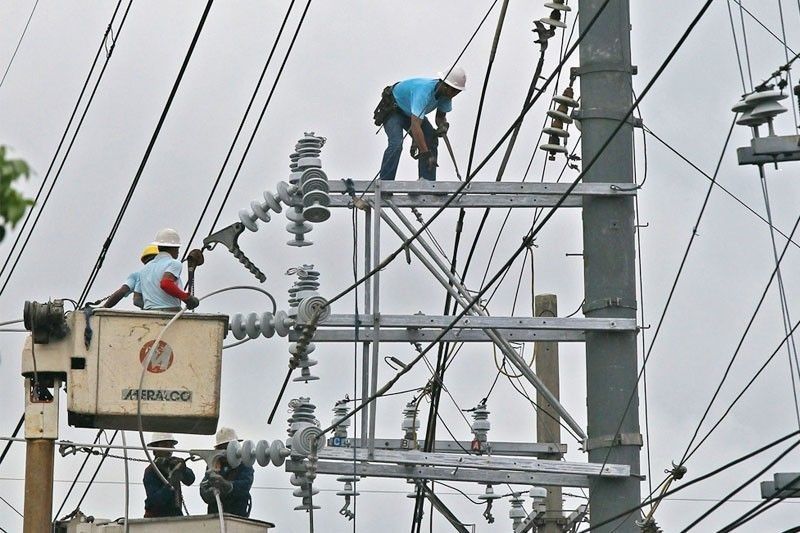Meralco uncertain on electricity rate increase next month

MANILA, Philippines — Manila Electric Co. (Meralco) is uncertain if electricity rates will increase in May due to the recent power outages.
“We have noted possible declining costs of natural gas and coal for power generation but their effect may be offset by recent reports of increases in spot market prices due to the simultaneous outage of several generating plants,” Meralco spokesman and public information office head Joe Zaldarriaga said in a text message.
“We are also not certain if it is indeed an increase,” he added.
Meralco earlier implemented an increase of 6.33 centavos per kilowatt hour (kwh), from P10.4961 per kwh last March to P10.5594 per kwh this month.
According to news reports, Wholesale Electricity Spot Market (WESM) prices are expected to increase by P1.523 kwh next month due to strained power supply.
Consumer group Laban Konsyumer Inc. (LKI) earlier called on the Energy Regulatory Commission (ERC), Department of Energy (DOE) and WESM operator to impose a price cap following the declaration of the yellow and red alerts over the Luzon grid in recent weeks.
“I also suggest and recommend that the regulators follow the money trail. Who are the suppliers that are taking advantage of the supply deficiency? Industry should be transparent. Consumers have the right to know what is happening to the grid,” LKI president Vic Dimagiba said in a position paper.
Dimagiba said based on Chapter 6 of WESM Rules, spot market operators are allowed to implement market suspension and impose an “administrative price cap” under certain conditions to assure price behavior to be approved by the ERC.
He cited the weekly summary report of WESM for weeks 14 and 15 or from April 1 to 14, showing that the hourly profile of load weighted average prices for Luzon ranges from a low of P4,000 to a high of P38,000 per megawatt (MW) hour.
“The industry is fully aware that demand for power continues to grow in Luzon. Supply is not catching up. Not enough new power plants to meet growing demand and corresponding reserves,” Dimagiba added.
He said consumers are now experiencing almost daily red alerts and rotating blackouts due to increasing demand and inadequate supply.
“The yellow and red alerts also cause spikes in prices, especially in the spot market. The committee must look into the bidding behavior before, during and after the yellow and red alerts to see who has been taking advantage of the supply deficiency at the expense and to the detriment of the consumers,” Dimagiba said.
The National Grid Corp. of the Philippines (NGCP) lifted its yellow alert status on the Luzon grid Friday afternoon due to declining demand.
The Luzon grid has been put under red and yellow alert status in recent days due to the magnitude 6.1 earthquake that struck Zambales and other parts of Luzon last Monday.
DOE Undersecretary Felix William Fuentebella earlier said the supply shortage in the power grid is due to the “delayed entry of plants affected by the earthquake.”
The Luzon power grid lost a total of 1,527 MW due to downed power plants and facilities operating on limited capacity, data from the DOE showed.
Yellow alert
As this developed, the DOE is called on to have more transparency on plant outages and the power situation as the Luzon grid is placed on yellow alert anew.
For the third straight day, the NGCP raised a yellow alert status on the Luzon grid from 1 p.m. to 4 p.m. yesterday due to insufficient operating reserve.
A yellow alert means there are not enough reserves to cover the largest running generating unit at the time but does not necessarily lead to power outages.
Power plants still on unplanned outage include Pagbilao 3 (420 MW), Masinloc 2 (344 MW), Pagbilao 1 (382 MW), SLTEC 1 (150 MW) and Malaya 2 (350 MW).
Meanwhile, plants with de-rated capacity are Calaca 2 at 200 MW (from 300 MW) and SLPGC 2 at 100 MW (from 150 MW).
“Unfortunately, in the last three days, we had some reduction of power reserves,” DOE-Electric Power Industry Management Bureau director Mario Marasigan said at a Senate hearing last Friday.
Last Tuesday, demand had gone up to 10,267 MW, which pushed contingency reserve to fall below the prescribed level of 647 MW – or the capacity of the largest unit – in the Luzon grid.
The DOE has also called on industry players not to announce grid alert status ahead of time to prevent causing alarm.
“It’s causing alarm to consumers and at the end of the day we don’t want the situation to be taken advantage of by some players in the sector,” Marasigan said.
But LKI insisted that the DOE should announce instances of yellow alerts raised in the power grid due to a Freedom of Information (FOI) order.
“Because of FOI, if the DOE will not overturn its gag order, we can file a case with the ombudsman,” LKI’s Dimagiba said. “This is giving undue benefit to power plants at the expense of the consumers according to section 3 of the Anti-Graft law.”
Former Senate president and Puwersa ng Masang Pilipino senatorial candidate Juan Ponce Enrile underscored yesterday the need to revisit the Electric Power Industry Reform Act (EPIRA) amid the threat of power outages and power rate increases.
Enrile, who continued the northern leg of his campaign rally in Quezon province, lamented that power rates are poised to go up following widespread power shortages in Luzon and Metro Manila the past few weeks.
“Consumers are the ones suffering the most. They are already being hit by these power outages and yet they have to pay more with bigger electricity bills due in the following months,” Enrile said in Tayabas town.
Enrile said he is baffled by the power plants having problems simultaneously. He added that he supported the investigation on the issue.
“We cannot sit on our hands waiting for the next series of power outages to happen again,” Enrile said.
Enrile, an advocate of consumer protection, said it is high time the government reviews its concessions agreement with power firms.
He also blamed EPIRA for the current shortfall in the power supply.
Enrile, who was the only senator who opposed EPIRA when it was passed in 2001, said the law failed to fulfill its promise of reducing electricity rates.
Bioethanol industry
Meanwhile, the House of Representatives is helping the bioethanol industry resolve the problems it is facing to make it viable.
Speaker Gloria Macapagal-Arroyo convened last Friday an oversight meeting attended by the industry’s stakeholders. She called for the meeting after her visit to a bioenergy plant in San Carlos City, Negros Occidental.
Industry leaders told Arroyo that they have to be allowed to import molasses to be converted to export-ready bioethanol for them to earn extra income.
The bioethanol makers added that their products are sold at a low price. Local users, they added, do not buy large quantities.
Arroyo signed Republic Act No. 9367 or the Biofuels Act in 2006 when she was president.
RA 9367 aimed to lessen the country’s dependence on imported oil and petroleum products.
Under the law, molasses produced locally and its byproduct could be sold only in the domestic market.
Responding to queries from Arroyo and other House members, Assistant Secretary Leonido Pulido III of the DOE said there is no legal obstacle to the importation of molasses and other non-sugar feed stock as long as the finished products are exported.
On the other hand, Rosemarie Gumera of the Sugar Regulatory Agency said her agency would not object to the molasses importation on the same condition.
Arroyo urged the agencies to ensure that finished products are exported and not sold in the domestic market, as the law requires.
Other House members who attended the meeting included Albee Benitez of Negros Occidental, Danilo Suarez of Quezon, Arnulfo Teves of Negros Oriental and Geraldine Roman of Bataan. – With Danessa Rivera, Jose Rodel Clapano, Jess Diaz
- Latest
- Trending
































